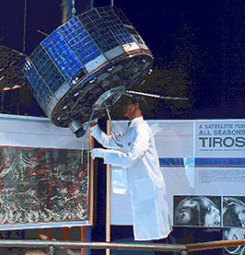2020 marks the 60th anniversary of the first weather satellite, Tiros 1 by NASA. Launched on April 1, 1960 at 11:40:09 UTC, Tiros-1 was the first successful low-Earth orbital weather satellite. It was a major test for not just weather satellites, but of satellites in general.
The TIROS Program was NASA’s first experimental step to determine if satellites could be useful in the study of the Earth. Therefore, TIROS-1 and its successors test various designs for spacecrafts, such as interments, data, and operational parameters. These tests were done with the goal of improving satellite applications for Earth-based monitoring.
Because weather forecasting was deemed the most promising application of space-based observation, the TIROS-1 program made this the priority. The hard work payed off as TIROS provided meteorologists data from its two cameras until 1962.
The Legacy Of Tiros-1
As a result of Tiros-1, weather satellites have become ubiquitous to live today. These satellites have become tools of daily lives without realizing it with regards to helping predict weather. Moreover, these satellites have helped with tracking ash from the Mt. St. Helens eruption and with the tracking of smoke from major forest fires.
There are 2 main types of weather satellites, Geostationary and Polar Orbiting. Geostationary weather satellites orbit the Earth above the equator at altitudes of 35,880 km (22,300 miles). Because of this orbit, they remain stationary with respect to the rotating Earth and thus can record or transmit images of the entire hemisphere below continuously with their visible-light and infrared sensors. The news media use the geostationary photos in their daily weather presentation as single images or made into movie loops. These are also available on the city forecast pages of www.noaa.gov.
Polar orbiting weather satellites circle the Earth at a typical altitude of 850 km (530 miles) in a north to south (or vice versa) path, passing over the poles in their continuous flight. Polar orbiting weather satellites are in sun-synchronous orbits, which means they are able to observe any place on Earth and will view every location twice each day with the same general lighting conditions due to the near-constant local solar time. Polar orbiting weather satellites offer a much better resolution than their geostationary counterparts due their closeness to the Earth.
Future Of Weather Satellites
The future of is wide open and is looking to change dramatically. As cubesats, newer technologies, new space companies, and lowered costs play into the future of weather satellite technology, the future will change dramatically. The costs will go down, and with cubesats in use by private newspace companies, there are opportunities for more localized, specialized, and cheaper weather forecasts.

Be the first to comment on "Celebrating 60 Years Of Weather Satellites"